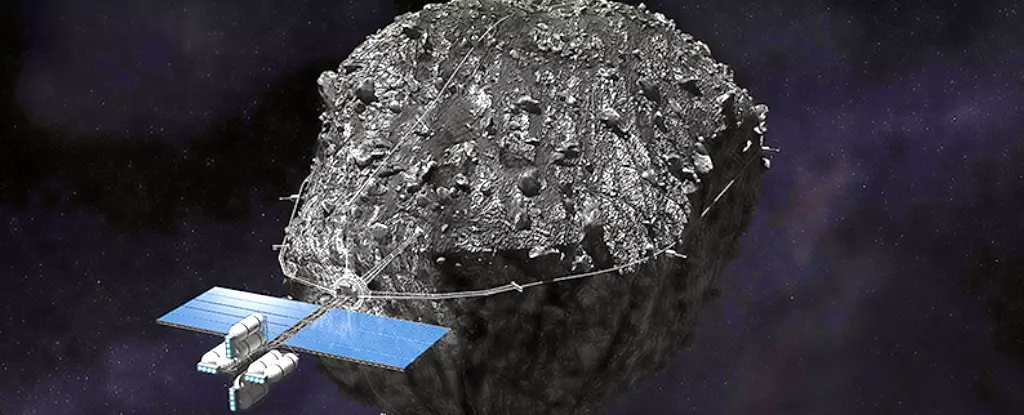Asteroid mining has captured the imagination of scientists, entrepreneurs, and journalists alike. The grandiose claims of untold riches dwelling in these celestial bodies often lead to sensational headlines, depicting the potential value of asteroids in staggering numbers. One example is the discussion around the metallic asteroid Psyche, touted in various sources as being worth a trillion-trillion dollars—a figure which, while striking, necessitates scrutiny and a grounded understanding of what such valuations truly entail.
Recent research, notably a paper supported by Astroforge, delves deeply into the actual metals available on asteroids and assesses their viability for extraction. The conclusions drawn from this analysis serve as a reality check against the rampant speculation that often dominates discussions of asteroid wealth. It divides the materials present in asteroids into two primary categories: those with potential value for terrestrial return, primarily platinum-group metals (PGMs), and those more suited for in-situ applications, such as iron and aluminum.
Platinum-group metals—desirable due to their rarity, high cost, and usefulness in modern technologies—are indeed prime candidates for extraction. Commonly utilized in industries like automotive manufacturing for catalytic converters, these metals present the most compelling case for returning to Earth. Conversely, structural metals conducive to in-space construction possess little economic incentive to transport back to our planet, given their relatively low prices. This raises a fundamental question: how can we successfully justify the initiation of asteroid mining ventures without concrete demand for their raw materials?
One major finding from the research challenges the assumption that asteroids are predominantly made up of pure metal. The notion that such celestial bodies are vast reservoirs of precious resources is largely overstated. Innovative analysis from meteorite samples, which act as proxies for their larger asteroid counterparts, indicates that while asteroids do contain valuable materials, their metal concentrations are often miscalculated.
Furthermore, the paper takes a critical look at a foundational study that previously influenced perceptions of asteroid composition, revealing that while PGMs might be present, they exist in lower concentrations than once assumed. Nevertheless, exciting developments arise when discussing refractory metal nuggets (RMNs). Found predominantly in L-type asteroids and often forming as tiny inclusions within calcium aluminum structures, RMNs may harbor concentrations of PGMs that dwarf terrestrial deposits, making them enticing targets for future exploration and mining initiatives.
The category of metals pertinent for in-space development presents its own set of challenges. While initial predictions about their abundance seem sound, the process of extracting these metals from their oxidized forms requires considerable energy—an often-overlooked aspect of asteroid mining. High-energy procedures, like molten regolith electrolysis, emerge as necessary but prohibitively expensive methods for material extraction.
Herein lies a classic dilemma often referred to as the ‘chicken-and-egg problem’. To establish a self-sufficient mining operation in space, one would require an energy source significant enough to process raw materials, which, in turn, necessitates the very materials that need processing. This cyclical dependency complicates the feasibility of asteroid mining; however, it’s a challenge that progressive companies, including Astroforge, are keen to tackle.
Astroforge’s upcoming mission, set to rendezvous with near-Earth asteroids, symbolizes a leap forward in our understanding of asteroid composition and the feasibility of mining. While advocacy for asteroid mining often paints an optimistic picture of wealth, the actual process demands careful planning and research. The mission’s outcomes could illuminate which asteroids may warrant further study and ultimately serve as valuable resources.
Such exploration represents a critical step, not only for the commercial viability of asteroid mining but also for the larger narrative of humanity’s relationship with outer space resources. The road ahead is undeniably fraught with challenges; overcoming the logistics of extraction, processing, and energy requirements is paramount for determining whether the riches of space can transition from tantalizing theory to tangible reality.
While the prospect of asteroid mining presents a unique opportunity for future resource gathering, it demands a rigorous examination of its practicality and potential for economic benefit. As we venture into this new frontier, maintaining a balanced perspective grounded in scientific inquiry will be essential for harnessing the true value these distant rocks might offer.



Leave a Reply